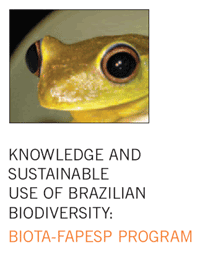Biota
Knowledge and sustainable use of Brazilian biodiversity: Biota-FAPESP Program (book in pdf format) Versão em português

Brazil is the country with the greatest biodiversity, being home to between 15 and 20 per cent of the total number of species on the planet, in six large biomas: Amazonia, Caatinga, Atlantic Rainforest, Cerrado, Pantanal and Pampa. The exact dimension of this biological wealth will probably never be known, given the continental dimensions of the country, the extent of its marine platform and the complexity of its ecosystems. A considerable part of this patrimony has been, and continues to be, irreversibly lost, even before it was known, due principally to the fragmentation of habitats, excessive exploitation of natural resources and contamination of the ground, the waters and the atmosphere.
Knowledge and conservation of these biomas and their flora, fauna and microorganisms is essential, for the very preservation of life on the planet. Aware of this, the State of São Paulo Research Foundation (FAPESP), one of Brazil’s principal agencies for the funding of scientific and technological research, has played an outstanding role in these endeavors to map the biodiversity in the State of São Paulo. Located in the southeast of Brazil, on the frontier between tropical and subtropical regions, São Paulo presents an enormous topographical and climatic diversity, representing an area of transition (ecotone) between two biomas – Atlantic Rainforest and Cerrado – with different ecosystems and enormous biological richness.
In addition to supporting individual projects which lead to a better understanding of Brazilian nature, as it has done for more than four decades, FAPESP supports projects of long duration, with multi-institutional bases, such as the thematic Phanerogamic Flora of the State of São Paulo, a survey of the diversity of plants with flowers begun in 1994, which uncovered a large number of new species and the results of which are being published. In 1999, working closely with the scientific community, FAPESP created the Biota-FAPESP Program, aimed not only at discovering, mapping and analyzing the origins, diversity and distribution of the flora and fauna of the State of São Paulo, but also at evaluating the possibilities of sustainable exploitation of plants or animals with economic potential and assisting in the formulation of conservation policies on forest remnants.
In nine years, the Program has supported 84 projects – including Thematic Projects, Support for Regular Research or awards developed in the Support for Young Researchers Program – and 400 grants, ranging from Scientific Initiation to Post-doctorate . This publication includes information on projects approved under Biota-FAPESP since the start of the program on March, 25 1999, up to July 2008. It also includes a collection of features on the Program, published in Pesquisa FAPESP magazine.
